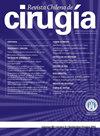食管癌半前位经胸微创食管切除术的初步经验
Q4 Medicine
引用次数: 2
摘要
食管癌的手术治疗具有高发病率和高死亡率。引入微创入路的目的是减少术后发病率。目的:介绍半俯卧位经胸微创食管切除术(MIE)的手术方法及手术效果。材料和方法:描述性队列研究。2013年4月至2017年5月期间,接受选择性MIE治疗的癌症患者被纳入研究。记录人口统计学、围手术期、病理和生存变量。结果:我们纳入了33例患者(24例男性,年龄69岁,91%有合并症)。肿瘤主要发生在食管中下三分之一(90%)。15例(45%)患者接受了新辅助治疗。没有转开胸的病例。胃重建率为93%。颈吻合术66%,胸吻合术30%。手术时间420 (330 ~ 570)min,出血200 (20 ~ 700)cc, 90天死亡率为0%。总发病率为78%,肺炎发生率为15%,9%需要再次手术。住院时间23 (11-81)d。组织学为鳞状癌占51%,腺癌占45%。利润率为87%。淋巴结数达到30(9-45)个。总的2年生存率为68%。结论:该技术初步效果良好,无术后死亡病例。肿瘤学结果显示高比例的RO手术和足够的淋巴结计数。本文章由计算机程序翻译,如有差异,请以英文原文为准。
Experiencia inicial con esofagectomia mínimamente invasiva transtorácica en posición semiprono por cáncer esofágico
Introduction: Surgical treatment of esophageal cancer is associated with high morbidity and mortality. The minimally invasive approach has been introduced with the aim of reducing postoperative morbidity. Aim: To describe the surgical technique and the results of transthoracic minimally invasive esophagectomy (MIE) in semiprone position. Material and Methods: Descriptive cohort study. Patients with an elective MIE for cancer were included between April 2013 and May 2017. Demographic, perioperative, pathology and survival variables were recorded. Results: We included 33 patients (24 men, age 69 years, 91% with comorbidities). The predominant location of the tumor was in the middle and lower thirds of the esophagus (90%). Fifteen (45%) patients received neoadjuvant treatment. There were no cases of conversion to thoracotomy. The reconstruction was performed with stomach in 93%. Cervical anastomosis was performed in 66% and thoracic anastomosis in 30%. The operative time was 420 (330-570) minutes and bleeding 200 (20-700) cc. The 90-day mortality rate was 0%. Overall morbidity was 78%, there was a 15% occurrence of pneumonia and 9% required a reoperation. The hospital stay was 23 (11-81) days. The histology was squamous carcinoma in 51% and adenocarcinoma in 45%. Margins were RO at 87%. The lymph node count reached 30 (9-45) lymph nodes. Overall 2-year survival is 68%. Conclusion: The preliminary results of this technique are favorable, without any case of postoperative mortality. The oncological results demonstrate a high percentage of RO surgery and adequate lymph node count.
求助全文
通过发布文献求助,成功后即可免费获取论文全文。
去求助
来源期刊

Revista Chilena De Cirugia
Medicine-Surgery
CiteScore
0.20
自引率
0.00%
发文量
0
审稿时长
6-12 weeks
期刊介绍:
La Revista Chilena de Cirugía es un órgano de difusión del conocimiento y actividad quirúrgica. Su población objetivo son cirujanos, especialistas de otras áreas médicas, médicos generales y alumnos del área de la salud.
Sirve a cirujanos y otros especialistas, para publicar artículos originales e inéditos sobre temas médicos, en particular artículos de investigación básica y clínica, artículos de revisión, entre otros.
Buscan difundir y actualizar el conocimiento médico general y quirúrgico en particular. Se publica en forma bimestral.
La Revista Chilena de Cirugía está afiliada y patrocinada por la Sociedad de Cirujanos de Chilese desde el año 1952.
 求助内容:
求助内容: 应助结果提醒方式:
应助结果提醒方式:


